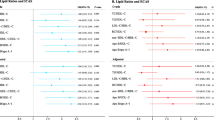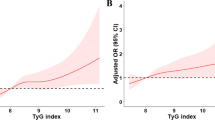Abstract
Objective
Lipid abnormalities are important risk factors in patients with large atherosclerotic strokes. Recent studies have shown that non-traditional lipid parameters are crucial to the development of atherosclerosis and are closely related to the clinical outcome of acute ischemic stroke (AIS). Therefore, we aimed to investigate the relationship between non-traditional lipid parameters and carotid plaque stability and stenosis degree in patients with large atherosclerotic stroke.
Methods
We retrospectively analyzed 336 patients with AIS. All patients were divided into the non-plaque group, stable plaque group, and vulnerable plaque group according to ultrasound examination. At the same time, the patients were divided into non-stenosis, mild stenosis, moderate stenosis, and severe stenosis groups according to the degree of stenosis. Non-traditional lipid parameters, including residual lipoprotein cholesterol (RLP-C), non-high-density lipoprotein cholesterol (non-HDL-C), non-HDL-C to high-density lipoprotein cholesterol ratio (non-HDL-C/HDL-C), triglyceride to HDL-C ratio (TG/HDL-C), Castelli’s risk index (CRI), and the atherogenic index of plasma (AIP). Receiver operating characteristic (ROC) curves and multivariate logistic regression analyses were used to investigate the associations between the non-traditional lipid parameters and carotid plaque vulnerability. Spearman linear correlation analysis was used to test the correlation between variables and the degree of carotid plaque stenosis.
Results
This study population included 336 patients with AIS, of whom 294 had a carotid plaque. Multivariate logistic regression model showed that RLP-C (OR, 3.361; 95%CI, 1.311–8.617), non-HDL-C/HDL-C (OR, 1.699; 95%CI, 1.279–2.258), non-HDL-C (OR, 1.704; 95%CI, 1.143–2.540), CRI-I (OR, 1.573; 95%CI, 1.196–2.068), and CRI-II (OR, 2.022; 95%CI, 1.369–2.985) were independent risk factors for carotid plaque vulnerability. In addition, Spearman correlation analysis showed that the values of RLP-C, non-HDL-C/HDL-C, non-HDL-C, TG/HDL-C, CRI-I, CRI-II, and AIP on admission were positively correlated with the degree of carotid plaque stenosis (all P < 0.001).
Conclusion
This study provides evidence that non-traditional lipid parameters (LP-C, non-HDL-C/HDL-C, non-HDL-C, CRI-I, and CRI-II) were potential predictors of carotid plaque vulnerability in patients with AIS. However, no significant correlation was observed between TG/HDL-C and AIP. RLP-C, non-HDL-C/HDL-C, non-HDL-C, TG/HDL-C, CRI-I, CRI-II, and AIP were closely related to the degree of carotid plaque stenosis. Non-traditional lipid parameters can be used as novel biomarkers of carotid plaque vulnerability and stenosis.




Similar content being viewed by others
References
Diseases GBD, Injuries C (2020) Global burden of 369 diseases and injuries in 204 countries and territories, 1990–2019: a systematic analysis for the Global Burden of Disease Study 2019. [J].Lancet 396(10258):1204–1222. https://doi.org/10.1016/S0140-6736(20)30925-9
Freilinger T, Dimitriadis K, Nikolaou K et al (2011) Stroke while squeezing a pimple: traumatic rupture of a vulnerable carotid artery plaque. [J].Neurology 76(3):305–6. https://doi.org/10.1212/WNL.0b013e3182074be8
Puig N, Jiménez-Xarrié E, Camps-Renom P et al (2020) Search for reliable circulating biomarkers to predict carotid plaque vulnerability. [J] Int J Mol Sci 21(21):8236. https://doi.org/10.3390/ijms21218236
van DamNolen DHK, van Dijk AC, Crombag G et al (2021) Lipoprotein(a) levels and atherosclerotic plaque characteristics in the carotid artery: the plaque at RISK (PARISK) study. [J].Atherosclerosis 329:22–29. https://doi.org/10.1016/j.atherosclerosis.2021.06.004
Anderson TJ, Grégoire J, Pearson GJ et al (2016) 2016 Canadian Cardiovascular Society guidelines for the management of dyslipidemia for the prevention of cardiovascular disease in the adult. [J].Can J Cardiol 32(11):1263–1282. https://doi.org/10.1016/j.cjca.2016.07.510
Mach F, Baigent C, Catapano AL et al (2020) 2019 ESC/EAS Guidelines for the management of dyslipidaemias: lipid modification to reduce cardiovascular risk. [J].Eur Heart J 41(1):111–188. https://doi.org/10.1093/eurheartj/ehz455s
Hu W, Wei R, Wang L et al (2018) Correlations of MMP-1, MMP-3, and MMP-12 with the degree of atherosclerosis, plaque stability and cardiovascular and cerebrovascular events. [J].Exp Ther Med 15(2):1994–1998. https://doi.org/10.3892/etm.2017.5623
Chin J, Mori TA, Adams LA et al (2020) Association between remnant lipoprotein cholesterol levels and non-alcoholic fatty liver disease in adolescents. [J].JHEP Reports 2(6):100150. https://doi.org/10.1016/j.jhepr.2020.100150
Guo J, Wang A, Wang Y et al (2021) Non-traditional lipid parameters as potential predictors of asymptomatic intracranial arterial stenosis. [J].Front Neurol 12:679415. https://doi.org/10.3389/fneur.2021.679415
Grant EG, Benson CB, Moneta GL et al (2003) Carotid artery stenosis: gray-scale and Doppler US diagnosis–Society of Radiologists in Ultrasound Consensus Conference. [J].Radiology 229(2):340–6. https://doi.org/10.1148/radiol.2292030516
Hartley A, Haskard D, Khamis R (2019) Oxidized LDL and anti-oxidized LDL antibodies in atherosclerosis - novel insights and future directions in diagnosis and therapy. [J].Trend Cardio Med 29(1):22–26. https://doi.org/10.1016/j.tcm.2018.05.010
Amarenco P, Hobeanu C, Labreuche J et al (2020) Carotid atherosclerosis evolution when targeting a low-density lipoprotein cholesterol concentration <70 mg/dL After an ischemic stroke of atherosclerotic origin. [J].Circulation 142(8):748–757. https://doi.org/10.1161/circulationaha.120.046774
Hou Q, Li S, Gao Y et al (2018) Relations of lipid parameters, other variables with carotid intima-media thickness and plaque in the general Chinese adults: an observational study. [J].Lipids Health Dis 17(1):107. https://doi.org/10.1186/s12944-018-0758-9
Ma C, Gurol ME, Huang Z et al (2019) Low-density lipoprotein cholesterol and risk of intracerebral hemorrhage: a prospective study. [J].Neurology 93(5):e445–e457. https://doi.org/10.1212/wnl.0000000000007853
Tang M, Zhao Q, Yi K et al (2022) Association between four nontraditional lipids and ischemic stroke: a cohort study in Shanghai, China. [J].Lipids Health Dis 21(1):72. https://doi.org/10.1186/s12944-022-01683-1
Yang Z, Ming XF (2006) Recent advances in understanding endothelial dysfunction in atherosclerosis. [J].Cli Med Res 4(1):53–65. https://doi.org/10.3121/cmr.4.1.53
Langsted A, Madsen CM, Nordestgaard BG (2020) Contribution of remnant cholesterol to cardiovascular risk. [J].J Intern Med 288(1):116–127. https://doi.org/10.1111/joim.13059
Liu L, Wen T, Zheng XY et al (2009) Remnant-like particles accelerate endothelial progenitor cells senescence and induce cellular dysfunction via an oxidative mechanism. [J].Atherosclerosis 202(2):405–14. https://doi.org/10.1016/j.atherosclerosis.2008.05.024
Kim JY, Park JH, Jeong SW et al (2011) High levels of remnant lipoprotein cholesterol is a risk factor for large artery atherosclerotic stroke. [J]J Clinical Neurol 7(4):203–9. https://doi.org/10.3988/jcn.2011.7.4.203
Qian S, You S, Sun Y et al (2021) Remnant cholesterol and common carotid artery intima-media thickness in patients with ischemic stroke. [J].Circ Cardiovasc Imaging 14(4):e010953. https://doi.org/10.1161/circimaging.120.010953
Plakogiannis R, Saseen JJ, Stefanidis A (2021) Pharmacists’ utilization of non-HDL-C levels in managing patients with lipid disorders. [J].Hosp Pharma 56(4):378–383. https://doi.org/10.1177/0018578720910380
Saito I, Yamagishi K, Kokubo Y et al (2020) Non-high-density lipoprotein cholesterol and risk of stroke subtypes and coronary heart disease: the Japan public health center-based prospective (JPHC) study. [J].J Atheroscler Thromb 27(4):363–374. https://doi.org/10.5551/jat.50385
Imamura T, Doi Y, Ninomiya T et al (2014) Non-high-density lipoprotein cholesterol and the development of coronary heart disease and stroke subtypes in a general Japanese population: the Hisayama Study. [J].Atherosclerosis 233(2):343–348. https://doi.org/10.1016/j.atherosclerosis.2014.01.005
Iannuzzi A, Giallauria F, Gentile M et al. (2021) Association between non-HDL-C/HDL-C ratio and carotid intima-media thickness in post-menopausal women. [J]. J Clin Med 11(1):78. https://doi.org/10.3390/jcm11010078
Liu H, Liu K, Pei L et al (2021) Atherogenic index of plasma predicts outcomes in acute ischemic stroke. [J].Frontiers in neurology 12:741754. https://doi.org/10.3389/fneur.2021.741754
Khosravi A, Sadeghi M, Farsani ES et al (2022) Atherogenic index of plasma: a valuable novel index to distinguish patients with unstable atherogenic plaques. [J].J Res Med Sci 27:45. https://doi.org/10.4103/jrms.jrms_590_21
Cai G, Shi G, Xue S et al (2017) The atherogenic index of plasma is a strong and independent predictor for coronary artery disease in the Chinese Han population. [J].Medicine 96(37):e8058. https://doi.org/10.1097/md.0000000000008058
Onat A, Can G, Kaya H et al (2010) “Atherogenic index of plasma” (log10 triglyceride/high-density lipoprotein-cholesterol) predicts high blood pressure, diabetes, and vascular events. [J].J Clin Lipid 4(2):89–98. https://doi.org/10.1016/j.jacl.2010.02.005
Wang C, Du Z, Ye N et al (2020) Using the atherogenic index of plasma to estimate the prevalence of ischemic stroke within a general population in a rural area of China. [J].Biomed Res Int 2020:7197054. https://doi.org/10.1155/2020/7197054
Garg R, Knox N, Prasad S et al (2020) The atherogenic index of plasma is independently associated with symptomatic carotid artery stenosis. [J].J Stroke Cerebrovasc Dis 29(12):105351. https://doi.org/10.1016/j.jstrokecerebrovasdis.2020.105351
Deng QW, Li S, Wang H et al (2018) The short-term prognostic value of the triglyceride-to-high-density lipoprotein cholesterol ratio in acute ischemic stroke. [J].Aging Dis 9(3):498–506. https://doi.org/10.14336/ad.2017.0629
Zhou L, Mai J, Li Y et al (2020) Triglyceride to high-density lipoprotein cholesterol ratio and risk of atherosclerotic cardiovascular disease in a Chinese population. [J].Nutr Metab Cardiovasc Dis 30(10):1706–1713. https://doi.org/10.1016/j.numecd.2020.05.009
Johnston N, Jernberg T, Lagerqvist B et al (2006) Improved identification of patients with coronary artery disease by the use of new lipid and lipoprotein biomarkers. [J].Am J Card 97(5):640–5. https://doi.org/10.1016/j.amjcard.2005.09.123
Zhang Y, Tuomilehto J, Jousilahti P et al (2012) Total and high-density lipoprotein cholesterol and stroke risk. [J].Stroke 43(7):1768–74. https://doi.org/10.1161/strokeaha.111.646778
Sujatha R, Kavitha S (2017) Atherogenic indices in stroke patients: a retrospective study. [J].Iran J Neurol 16(2):78–82 (PMID: 28761629)
Fujihara K, Suzuki H, Sato A et al (2013) Carotid artery plaque and LDL-to-HDL cholesterol ratio predict atherosclerotic status in coronary arteries in asymptomatic patients with type 2 diabetes mellitus. [J].J Atheroscler Thromb 20(5):452–64. https://doi.org/10.5551/jat.14977
Acknowledgements
We thank all the enrolled patients and their families, paramedics, and all staff.
Author information
Authors and Affiliations
Corresponding author
Ethics declarations
Conflict of interest
The authors declare no competing interests.
Additional information
Publisher's Note
Springer Nature remains neutral with regard to jurisdictional claims in published maps and institutional affiliations.
Rights and permissions
Springer Nature or its licensor (e.g. a society or other partner) holds exclusive rights to this article under a publishing agreement with the author(s) or other rightsholder(s); author self-archiving of the accepted manuscript version of this article is solely governed by the terms of such publishing agreement and applicable law.
About this article
Cite this article
Zhao, Z., Wang, H., Hou, Q. et al. Non-traditional lipid parameters as potential predictors of carotid plaque vulnerability and stenosis in patients with acute ischemic stroke. Neurol Sci 44, 835–843 (2023). https://doi.org/10.1007/s10072-022-06472-3
Received:
Accepted:
Published:
Issue Date:
DOI: https://doi.org/10.1007/s10072-022-06472-3




